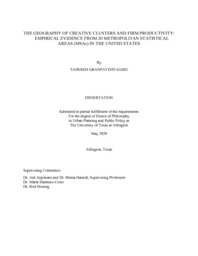| dc.description.abstract | The burgeoning research on creative clusters and an increased rate of municipal investment in creative policymaking are becoming dominant global trends. Yet, the factors that help foster creative-friendly communities and how much they relate to creative firm productivity remain insufficiently understood. This dissertation is a step forward in our knowledge of the geography and typology of creative clusters and their association with productivity in the United States. In this research, creative clusters refer to meaningful and statistically significant agglomerations of creative firms.
This research demonstrates that creative clusters have an “urban nature” in most cases, meaning that there is a higher propensity for creative clusters to be found in the inner parts of larger cities, within the Metropolitan Statistical Areas (MSAs). While it shows that some creative firms (e.g., film and media and performing arts) tend to cluster more than the others, the number and geographic size of creative clusters do not reflect the general pattern of creative employment and creative sales volume in the 20 MSAs that are studied.
The Herfindahl-Hirschman Index (HHI) analysis in chapter three exhibits that in most clusters, there is a meaningful and significant co-location of creative firms from more than one category, while about 30% of the clusters show levels of monopoly in them. In other words, in the study area, %30 of all creative firms are located within creative clusters, among which, one-third are monopolistic, meaning only one or two industries have the most (if not all) shares of employment and sales volume in those clusters. Moreover, the location quotient (LQ) analysis in these clusters delineates that these co-locations have specific patterns. For example, clusters of film, television, and cinema tend to locate close to clusters of performing arts, while gaming and software programming clusters have a slightly different pattern. The gaming and software programming firms locate farther from city centers and tend to create monopoly clusters for themselves. The suggested approach in this dissertation creates a systematic methodology that enables a comparative analysis across the country. It ranks creative clusters in terms of their size and regional competency while also identifying their particular specialization.
The analysis in chapter four demonstrates a positive and statistically significant relationship between the creative clusters and firm productivity for creative businesses, as is supported by the literature. The sales volume for creative firms within the clusters is significantly higher when compared to the non-cluster areas. While locating in creative clusters may be less affordable for creative firms, they may prefer these locations in the metropolitan areas due to different factors. The results of this research also show that it is not just some soft factors such as the creative image or local buzz (as discussed in chapter two) that may incentivize creative firms to cluster. Higher sales volumes are also related to creative firms in these clusters, highlighting the multi-dimensional benefits (one may be careful about the causal language here) of firm clustering for creative businesses. These clustering patterns confirm the theories that indicate access to the labor pool, the structure of consumption and technology, the need of face to face contact, urban buzz, and branding (Markusen and Gadwa 2010a; Currid and Williams 2010a; Vanolo 2008; Han and Hawken 2017; Scott 2006a; Evans 2009b) are some of the determinants of where creative and cultural firms tend to locate.
At the results of the logistic regression, it also appears that education, museum, and crafts are less clustering categories among creative firms. In other words, in tandem with the literature to some extent, the data shows that these three specializations of the creative economy are more dispersed, which is due to the nature of museums and collections, education (accessibility and the location of schools) and crafts businesses. I expected the performing arts businesses to have a lower probability of being located within the clusters than most other categories, since performing arts employees, including singers and dancers, are expected to be located near the churches in communities. Nevertheless, the data shows that performing arts has the third-highest probability of being located in clusters, only after the film and media industry and visual arts firms. In fact, 44.88 percent of performing arts firms are located within clusters, which is the highest share among all other creative categories.
This dissertation concludes by offering some policy recommendations to identify the creative clusters within the urban areas and promote creative-friendly communities, by building upon the fact that they are positively associated with firm productivity and their potential to contribute to economic development in the neighborhoods. It also attempts to address some of the negative externalities related to creative clusters, such as inequality in production and consumption of creative products, as well as gentrification and displacement, through the use of policies, strategies, and investment in the existing clusters. | |


